Continuous stochastic Schrodinger equations and localization
- 格式:pdf
- 大小:267.26 KB
- 文档页数:18
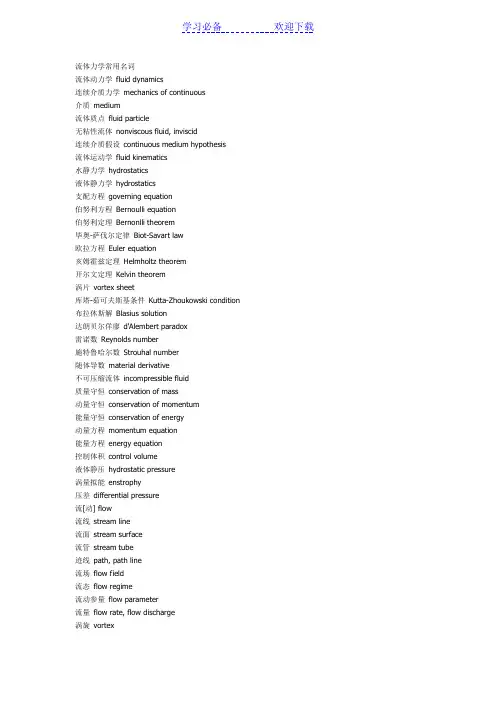
流体力学常用名词流体动力学fluid dynamics连续介质力学mechanics of continuous介质medium流体质点fluid particle无粘性流体nonviscous fluid, inviscid连续介质假设continuous medium hypothesis流体运动学fluid kinematics水静力学hydrostatics液体静力学hydrostatics支配方程governing equation伯努利方程Bernoulli equation伯努利定理Bernonlli theorem毕奥-萨伐尔定律Biot-Savart law欧拉方程Euler equation亥姆霍兹定理Helmholtz theorem开尔文定理Kelvin theorem涡片vortex sheet库塔-茹可夫斯基条件Kutta-Zhoukowski condition 布拉休斯解Blasius solution达朗贝尔佯廖d'Alembert paradox雷诺数Reynolds number施特鲁哈尔数Strouhal number随体导数material derivative不可压缩流体incompressible fluid质量守恒conservation of mass动量守恒conservation of momentum能量守恒conservation of energy动量方程momentum equation能量方程energy equation控制体积control volume液体静压hydrostatic pressure涡量拟能enstrophy压差differential pressure流[动] flow流线stream line流面stream surface流管stream tube迹线path, path line流场flow field流态flow regime流动参量flow parameter流量flow rate, flow discharge涡旋vortex涡量vorticity涡丝vortex filament涡线vortex line涡面vortex surface涡层vortex layer涡环vortex ring涡对vortex pair涡管vortex tube涡街vortex street卡门涡街Karman vortex street马蹄涡horseshoe vortex对流涡胞convective cell卷筒涡胞roll cell涡eddy涡粘性eddy viscosity环流circulation环量circulation速度环量velocity circulation偶极子doublet, dipole驻点stagnation point总压[力] total pressure总压头total head静压头static head总焓total enthalpy能量输运energy transport速度剖面velocity profile库埃特流Couette flow单相流single phase flow单组份流single-component flow均匀流uniform flow非均匀流nonuniform flow二维流two-dimensional flow三维流three-dimensional flow准定常流quasi-steady flow非定常流unsteady flow, non-steady flow 暂态流transient flow周期流periodic flow振荡流oscillatory flow分层流stratified flow无旋流irrotational flow有旋流rotational flow轴对称流axisymmetric flow不可压缩性incompressibility不可压缩流[动] incompressible flow浮体floating body定倾中心metacenter阻力drag, resistance减阻drag reduction表面力surface force表面张力surface tension毛细[管]作用capillarity来流incoming flow自由流free stream自由流线free stream line外流external flow进口entrance, inlet出口exit, outlet扰动disturbance, perturbation分布distribution传播propagation色散dispersion弥散dispersion附加质量added mass ,associated mass收缩contraction镜象法image method无量纲参数dimensionless parameter几何相似geometric similarity运动相似kinematic similarity动力相似[性] dynamic similarity平面流plane flow势potential势流potential flow速度势velocity potential复势complex potential复速度complex velocity流函数stream function源source汇sink速度[水]头velocity head拐角流corner flow空泡流cavity flow超空泡supercavity超空泡流supercavity flow空气动力学aerodynamics低速空气动力学low-speed aerodynamics 高速空气动力学high-speed aerodynamics 气动热力学aerothermodynamics亚声速流[动] subsonic flow跨声速流[动] transonic flow超声速流[动] supersonic flow锥形流conical flow楔流wedge flow叶栅流cascade flow非平衡流[动] non-equilibrium flow细长体slender body细长度slenderness钝头体bluff body钝体blunt body翼型airfoil翼弦chord薄翼理论thin-airfoil theory构型configuration后缘trailing edge迎角angle of attack失速stall脱体激波detached shock wave波阻wave drag诱导阻力induced drag诱导速度induced velocity临界雷诺数critical Reynolds number 前缘涡leading edge vortex附着涡bound vortex约束涡confined vortex气动中心aerodynamic center气动力aerodynamic force气动噪声aerodynamic noise气动加热aerodynamic heating离解dissociation地面效应ground effect气体动力学gas dynamics稀疏波rarefaction wave热状态方程thermal equation of state 喷管Nozzle普朗特-迈耶流Prandtl-Meyer flow瑞利流Rayleigh flow可压缩流[动] compressible flow可压缩流体compressible fluid绝热流adiabatic flow非绝热流diabatic flow未扰动流undisturbed flow等熵流isentropic flow匀熵流homoentropic flow兰金-于戈尼奥条件Rankine-Hugoniot condition 状态方程equation of state量热状态方程caloric equation of state完全气体perfect gas拉瓦尔喷管Laval nozzle马赫角Mach angle马赫锥Mach cone马赫线Mach line马赫数Mach number马赫波Mach wave当地马赫数local Mach number冲击波shock wave激波shock wave正激波normal shock wave斜激波oblique shock wave头波bow wave附体激波attached shock wave激波阵面shock front激波层shock layer压缩波compression wave反射reflection折射refraction散射scattering衍射diffraction绕射diffraction出口压力exit pressure超压[强] over pressure反压back pressure爆炸explosion爆轰detonation缓燃deflagration水动力学hydrodynamics液体动力学hydrodynamics泰勒不稳定性Taylor instability盖斯特纳波Gerstner wave斯托克斯波Stokes wave瑞利数Rayleigh number自由面free surface波速wave speed, wave velocity波高wave height波列wave train波群wave group波能wave energy表面波surface wave表面张力波capillary wave规则波regular wave不规则波irregular wave浅水波shallow water wave深水波deep water wave重力波gravity wave椭圆余弦波cnoidal wave潮波tidal wave涌波surge wave破碎波breaking wave船波ship wave非线性波nonlinear wave孤立子soliton水动[力]噪声hydrodynamic noise水击water hammer空化cavitation空化数cavitation number空蚀cavitation damage超空化流supercavitating flow水翼hydrofoil水力学hydraulics洪水波flood wave涟漪ripple消能energy dissipation海洋水动力学marine hydrodynamics 谢齐公式Chezy formula欧拉数Euler number弗劳德数Froude number水力半径hydraulic radius水力坡度hvdraulic slope高度水头elevating head水头损失head loss水位water level水跃hydraulic jump含水层aquifer排水drainage排放量discharge壅水曲线back water curve压[强水]头pressure head过水断面flow cross-section明槽流open channel flow孔流orifice flow无压流free surface flow有压流pressure flow缓流subcritical flow急流supercritical flow渐变流gradually varied flow急变流rapidly varied flow临界流critical flow异重流density current, gravity flow堰流weir flow掺气流aerated flow含沙流sediment-laden stream降水曲线dropdown curve沉积物sediment, deposit沉[降堆]积sedimentation, deposition沉降速度settling velocity流动稳定性flow stability不稳定性instability奥尔-索末菲方程Orr-Sommerfeld equation 涡量方程vorticity equation泊肃叶流Poiseuille flow奥辛流Oseen flow剪切流shear flow粘性流[动] viscous flow层流laminar flow分离流separated flow二次流secondary flow近场流near field flow远场流far field flow滞止流stagnation flow尾流wake [flow]回流back flow反流reverse flow射流jet自由射流free jet管流pipe flow, tube flow内流internal flow拟序结构coherent structure猝发过程bursting process表观粘度apparent viscosity运动粘性kinematic viscosity动力粘性dynamic viscosity泊poise厘泊centipoise厘沱centistoke剪切层shear layer次层sublayer流动分离flow separation层流分离laminar separation湍流分离turbulent separation分离点separation point附着点attachment point再附reattachment再层流化relaminarization起动涡starting vortex驻涡standing vortex涡旋破碎vortex breakdown涡旋脱落vortex shedding压[力]降pressure drop压差阻力pressure drag压力能pressure energy型阻profile drag滑移速度slip velocity无滑移条件non-slip condition壁剪应力skin friction, frictional drag壁剪切速度friction velocity磨擦损失friction loss磨擦因子friction factor耗散dissipation滞后lag相似性解similar solution局域相似local similarity气体润滑gas lubrication液体动力润滑hydrodynamic lubrication浆体slurry泰勒数Taylor number纳维-斯托克斯方程Navier-Stokes equation 牛顿流体Newtonian fluid边界层理论boundary later theory边界层方程boundary layer equation边界层boundary layer附面层boundary layer层流边界层laminar boundary layer湍流边界层turbulent boundary layer温度边界层thermal boundary layer边界层转捩boundary layer transition边界层分离boundary layer separation边界层厚度boundary layer thickness位移厚度displacement thickness动量厚度momentum thickness能量厚度energy thickness焓厚度enthalpy thickness注入injection吸出suction泰勒涡Taylor vortex速度亏损律velocity defect law形状因子shape factor测速法anemometry粘度测定法visco[si] metry流动显示flow visualization油烟显示oil smoke visualization孔板流量计orifice meter频率响应frequency response油膜显示oil film visualization阴影法shadow method纹影法schlieren method烟丝法smoke wire method丝线法tuft method 说明氢泡法nydrogen bubble method相似理论similarity theory相似律similarity law部分相似partial similarity定理pi theorem, Buckingham theorem静[态]校准static calibration动态校准dynamic calibration风洞wind tunnel激波管shock tube激波管风洞shock tube wind tunnel水洞water tunnel拖曳水池towing tank旋臂水池rotating arm basin扩散段diffuser测压孔pressure tap皮托管pitot tube普雷斯顿管preston tube斯坦顿管Stanton tube文丘里管Venturi tubeU形管U-tube压强计manometer微压计micromanometer多管压强计multiple manometer静压管static [pressure]tube流速计anemometer风速管Pitot- static tube激光多普勒测速计laser Doppler anemometer,laser Doppler velocimeter热线流速计hot-wire anemometer热膜流速计hot- film anemometer流量计flow meter粘度计visco[si] meter涡量计vorticity meter传感器transducer, sensor压强传感器pressure transducer热敏电阻thermistor示踪物tracer时间线time line脉线streak line尺度效应scale effect壁效应wall effect堵塞blockage堵寒效应blockage effect动态响应dynamic response响应频率response frequency底压base pressure菲克定律Fick law巴塞特力Basset force埃克特数Eckert number格拉斯霍夫数Grashof number努塞特数Nusselt number普朗特数prandtl number雷诺比拟Reynolds analogy施密特数schmidt number斯坦顿数Stanton number对流convection自由对流natural convection, free convec-tion 强迫对流forced convection热对流heat convection质量传递mass transfer传质系数mass transfer coefficient热量传递heat transfer传热系数heat transfer coefficient对流传热convective heat transfer辐射传热radiative heat transfer动量交换momentum transfer能量传递energy transfer传导conduction热传导conductive heat transfer热交换heat exchange临界热通量critical heat flux浓度concentration扩散diffusion扩散性diffusivity扩散率diffusivity扩散速度diffusion velocity分子扩散molecular diffusion沸腾boiling蒸发evaporation气化gasification凝结condensation成核nucleation计算流体力学computational fluid mechanics多重尺度问题multiple scale problem伯格斯方程Burgers equation对流扩散方程convection diffusion equationKDU方程KDV equation修正微分方程modified differential equation拉克斯等价定理Lax equivalence theorem数值模拟numerical simulation大涡模拟large eddy simulation数值粘性numerical viscosity非线性不稳定性nonlinear instability希尔特稳定性分析Hirt stability analysis相容条件consistency conditionCFL条件Courant- Friedrichs- Lewy condition ,CFL condition 狄里克雷边界条件Dirichlet boundary condition熵条件entropy condition远场边界条件far field boundary condition流入边界条件inflow boundary condition无反射边界条件nonreflecting boundary condition数值边界条件numerical boundary condition流出边界条件outflow boundary condition冯.诺伊曼条件von Neumann condition近似因子分解法approximate factorization method人工压缩artificial compression人工粘性artificial viscosity边界元法boundary element method配置方法collocation method能量法energy method有限体积法finite volume method流体网格法fluid in cell method,FLIC method通量校正传输法flux-corrected transport method通量矢量分解法flux vector splitting method伽辽金法Galerkin method积分方法integral method标记网格法marker and cell method, MAC method特征线法method of characteristics直线法method of lines矩量法moment method多重网格法multi- grid method板块法panel method质点网格法particle in cell method, PIC method质点法particle method预估校正法predictor-corrector method投影法projection method准谱法pseudo-spectral method随机选取法random choice method激波捕捉法shock-capturing method激波拟合法shock-fitting method谱方法spectral method稀疏矩阵分解法split coefficient matrix method不定常法time-dependent method时间分步法time splitting method变分法variational method涡方法vortex method隐格式implicit scheme显格式explicit scheme交替方向隐格式alternating direction implicit scheme, ADI scheme 反扩散差分格式anti-diffusion difference scheme紧差分格式compact difference scheme守恒差分格式conservation difference scheme克兰克-尼科尔森格式Crank-Nicolson scheme杜福特-弗兰克尔格式Dufort-Frankel scheme指数格式exponential scheme戈本诺夫格式Godunov scheme高分辨率格式high resolution scheme拉克斯-温德罗夫格式Lax-Wendroff scheme蛙跳格式leap-frog scheme单调差分格式monotone difference scheme保单调差分格式monotonicity preserving diffe-rence scheme穆曼-科尔格式Murman-Cole scheme半隐格式semi-implicit scheme斜迎风格式skew-upstream scheme全变差下降格式total variation decreasing scheme TVD scheme迎风格式upstream scheme , upwind scheme计算区域computational domain物理区域physical domain影响域domain of influence依赖域domain of dependence区域分解domain decomposition维数分解dimensional split物理解physical solution弱解weak solution黎曼解算子Riemann solver守恒型conservation form弱守恒型weak conservation form强守恒型strong conservation form散度型divergence form贴体曲线坐标body- fitted curvilinear coordi-nates [自]适应网格[self-] adaptive mesh适应网格生成adaptive grid generation自动网格生成automatic grid generation数值网格生成numerical grid generation交错网格staggered mesh网格雷诺数cell Reynolds number数植扩散numerical diffusion数值耗散numerical dissipation数值色散numerical dispersion数值通量numerical flux放大因子amplification factor放大矩阵amplification matrix阻尼误差damping error离散涡discrete vortex熵通量entropy flux熵函数entropy function分步法fractional step method。
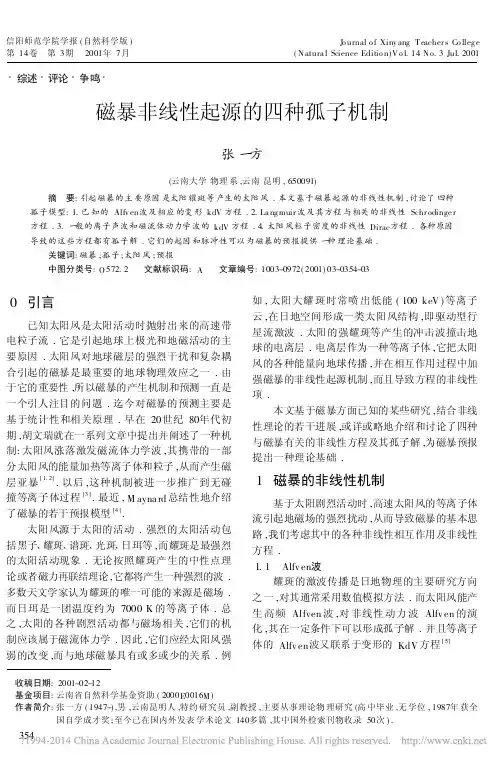
信阳师范学院学报(自然科学版)J o urnal o f Xiny ang T eacher s Co lleg e 第14卷 第3期 2001年7月(N atura l Science Editio n)V o l.14N o.3Jul.2001·综述·评论·争鸣·磁暴非线性起源的四种孤子机制张一方(云南大学物理系,云南昆明,650091)摘 要:引起磁暴的主要原因是太阳耀斑等产生的太阳风.本文基于磁暴起源的非线性机制,讨论了四种孤子模型:1.已知的Alfv en波及相应的变形kdV方程 ng muir波及其方程与相关的非线性Schr odinge r方程.3.一般的离子声波和磁流体动力学波的kdV方程.4.太阳风粒子密度的非线性Dirac方程.各种原因导致的这些方程都有孤子解.它们的起因和脉冲性可以为磁暴的预报提供一种理论基础.关键词:磁暴;孤子;太阳风;预报中图分类号:O572.2 文献标识码:A 文章编号:1003-0972(2001)03-0354-030 引言已知太阳风是太阳活动时抛射出来的高速带电粒子流.它是引起地球上极光和地磁活动的主要原因.太阳风对地球磁层的强烈干扰和复杂耦合引起的磁暴是最重要的地球物理效应之一.由于它的重要性,所以磁暴的产生机制和预测一直是一个引人注目的问题.迄今对磁暴的预测主要是基于统计性和相关原理.早在20世纪80年代初期,胡文瑞就在一系列文章中提出并阐述了一种机制:太阳风涨落激发磁流体力学波,其携带的一部分太阳风的能量加热等离子体和粒子,从而产生磁层亚暴[1,2].以后,这种机制被进一步推广到无碰撞等离子体过程[3].最近,M ayna rd总结性地介绍了磁暴的若干预报模型[4].太阳风源于太阳的活动.强烈的太阳活动包括黑子、耀斑、谱斑、光斑、日珥等,而耀斑是最强烈的太阳活动现象.无论按照耀斑产生的中性点理论或者磁力再联结理论,它都将产生一种强烈的波.多数天文学家认为耀斑的唯一可能的来源是磁场.而日珥是一团温度约为7000K的等离子体.总之,太阳的各种剧烈活动都与磁场相关,它们的机制应该属于磁流体力学.因此,它们应经太阳风强弱的改变,而与地球磁暴具有或多或少的关系.例如,太阳大耀斑时常喷出低能(100keV)等离子云,在日地空间形成一类太阳风结构,即驱动型行星流激波.太阳的强耀斑等产生的冲击波撞击地球的电离层.电离层作为一种等离子体,它把太阳风的各种能量向地球传播,并在相互作用过程中加强磁暴的非线性起源机制,而且导致方程的非线性项.本文基于磁暴方面已知的某些研究,结合非线性理论的若干进展,或详或略地介绍和讨论了四种与磁暴有关的非线性方程及其孤子解,为磁暴预报提出一种理论基础.1 磁暴的非线性机制基于太阳剧烈活动时,高速太阳风的等离子体流引起地磁场的强烈扰动,从而导致磁暴的基本思路,我们考虑其中的各种非线性相互作用及非线性方程.1.1 Alfv en波耀斑的激波传播是日地物理的主要研究方向之一,对其通常采用数值模拟方法.而太阳风能产生高频Alfven波,对非线性动力波Alfv en的演化,其在一定条件下可以形成孤子解.并且等离子体的Alfv en波又联系于变形的KdV方程[5] 收稿日期:2001-02-12 基金项目:云南省自然科学基金资助(2000E0016M) 作者简介:张一方(1947-),男,云南昆明人,特约研究员,副教授,主要从事理论物理研究(高中毕业,无学位,1987年获全国自学成才奖;至今已在国内外发表学术论文140多篇,其中国外检索刊物收录50次).354 u+T u2u x+V_xxx=0(1)取积分常数为零,则其孤子解为[6] u=6cT sec h cV(x-ct)(2)此时波速为c.1.2 Langm uir波已知电子振荡时会产生Lang muir波,而太阳风与其传遍过程及与地磁场相互作用时,存在大量电子振荡,所以Lang muir波是普遍存在的.Lin 等认为太阳耀斑中的高能电子经束流等离子体的不稳定性产生Langm uir波[7].又因为等离子体湍流时会激发出各种类型的波,其中对纵等离子激元当粒子束的速度远大于电子热速度时,通常被激发的波也是Lang muir波.非线性Langmuir波满足方程 i t E+3v2T2k2p52E=k p n el2n eoE(3)小振幅极限时n e=n e0+n,可以获得孤子解[8] n=-PQ sec h (P2Y)(4)另一方面,磁流体力学与高频等离子体波之间相互作用也导致Lang muir孤子[9].Fried等导出描述Lang muir波的方程也可以是非线性Schroding er方程[10] i H t+H xx+k|H|2H=0(5)它的孤子解是H=H0sec h[k2H0(x -u e t)]exp[i u e2(x-u c t)](6)此时ex p[i u e2(x-u c t)]就显示出时间上的周期性.1.3 一般的离子声波和磁流体动力学波在等离子体中,一般的离子声波和磁流体力学波可以用KdV方程描述[5].已知KdV方程为 u t+uu x+V u xxx=0(7)其非线性波解的基本形式是周期性的椭圆余弦波[6]u(x,t)=u2+(u1 -u2)cn2[u1-u312V(x-ct)](8)其中cn()为Jacobi椭圆余弦函数.u1,u2,u3是三次方程 u3-3cu2-6Au-6B=0(9)的三个根.A,B是kdV方程对Y=x-ct积分两次的积分常数.(8)的特殊情况之一是u2=u3的孤子解u(x,t)=u2+(u1 -u2)sec h2[u1-u212V(x-ct)](10) 1.4 太阳风粒子密度已知太阳风撞击地球时所具有的总能流约为 U m=c V2m(12d g2+B22_0)g(11)其中r m是地球磁层半径,d是太阳风的质量密度,v是粒子速度,B是行星际磁场强度.它不仅与动能和磁场强度密切相关,而且与粒子密度相关.而太阳风在产生和传播中,各种带电粒子主要是稳定的电子和质子,其可以用Dirac方程描述.并且粒子之间必然有相互作用,取最简单的结果,就可以引入存在自相互作用的非线性Dirac方程,其形式为 V__J+m J-l20J(J+J)=0(12)我们应用类似孤子解的方法[11],令Z= V T x T-V0ct1+c,则(12)化为 d J d Z=J(l20J+J-m)(13)对几率密度,其孤子解为 d=J+J=m2l20[ex p(2m Z+C)+1](14)我们曾用此定量描述过高能多重产生和广延大气簇射[11]2 讨论这些非线性方程还有多种彼此相关的孤子解.虽然对非线性方程通常的线性叠加原理不成立,但这些特解可以应用Backlank变换等方法进行非线性叠加,而导出众多新的解.这样,非线性方程及非线性波就呈现出丰富的复杂形式.数学上,非线性方程除了有孤子解外,还可以有混沌等其它解.例如,对一般的非线性规范场方程就有磁单极子解、双荷子解、瞬子解、半子解、膨胀子解、弦解、涡线解等.最近,我们由此得到一些可以描述相变的新的解[12].此时可以认为出现磁暴也是一种相变.而混沌解也许对应于大磁暴.同时,由于某些方程在一定条件下可以得到周期解,如(6)、(8).或者如果把太阳活动及其导致的太阳风作为一种外力,则磁暴就随周期性的外力355张一方:磁暴非线性起源的四种孤子机制而变化.这样就可以解释磁暴的周期性,特别是具有与太阳黑子及光斑相同的11年周期和27天周期.我们在本文中讨论的只是几种非线性波,及相应的非线性方程和孤子解.而太阳风和地球间的相互作用是极复杂的,太阳活动,如耀斑的出现又具有极大的突然性.如此,多种因素将产生多种不同的波,相应于多种方程及各种解.它们互相叠加,彼此影响就导致各种各样的相互关系,从而地地球空间形成多种波动的大合唱.这为复杂的磁暴现象提供了相应的数理背景,也为磁暴预测指出了一种理论基础.由太阳活动的各种指标,例如用耀斑的面积和亮度双重级别确定法等可以预测磁暴的变化.由太阳活动的周期性及方程的周期性可以为磁暴周期性的预测提出一种理论上的结果.同时,由它们的相互影响,又可以估计磁暴的变化.总之,太阳的各种变化都与地球密切相关,作为非线性日地物理学中的一个重要方面,它也具有非线性理论的一个主要特征:对初始条件的极端敏感性.参考文献:[1] 胡文瑞.太阳风湍流和磁层亚暴的一种机制[J].地球物理学报,1980,23(3):246-253.[2] 胡文瑞.阿尔文涨落与地球磁层亚暴[J].地球物理学报,1981,24(3):279-286.[3] 隆 辉,许乃怀,胡文瑞.太阳风动量涨落激发磁层亚暴的机制[J].地球物理学报,1985,28(2):127-132.[4] M A Y A RD N C.Space weather prediction[J].Rev Geo phy s,1995,(Suppl).547-557.[5] SCO T T A C,CHU F Y F,M CL AU G HLIN D W.The soliton:a new concept in applied science[J].Proc I EEE,1973,61(10):1443-1483.[6] 刘式适,刘式达,谭本道.非线性大气动力学[M].北京:国防工业出版社,1996.[7] L IN R P,PO T T ER D W,G U RN E T T D A,et al.Energetic electrons and plasma waves associated with a s olar type I I Iradio burst[J].Astro phy s J,1981,25(1):364-373.[8] 陈银华,陆 玮.含杂等离子体中的非线性Lang muir波[J].自然杂志,1999,21(1):59-60.[9] L I Xiao qing,ZHAN G Zhe nda.Magnetic reconnection by Langmuir solitons[J].Astro ph ys J,1997,479(2):1028-1034.[10] FRI ED B D,IC HIK AW A Y H.On the nonlinear Schrodinger equation for L angmuir waves[J].J Phy s Soc J a pa n,1973,34(5):1073-1082.[11] 张一方.粒子物理和相对论的新探索[M].昆明:云南科技出版社,1989.149-164.[12] 张一方,刘正荣.粒子的相互作用,极限环和相变[J].数学物理学报,1999,19(4)424-431.Nonlinear mechanism of four solitons on origin of magnetic stormsZHANG Yi-fang(Dept.of Phys.,Y unnan U niv e rsity,Kunming650091,China)Abstract:The kno w n cause o f m ag netic storm s is m ainly the Solar Wind produced by the solar flare,etc. Based on the no nlinea r mechanism of mag netic storm s,w e discuss the four ty pe mo dels:1.The modified kdV equatio n on the Alfv en wav e in a co llisionless plasma.2.The equatio n o f Lang muir w av es in plasma and correlativ e the no nlinear Sch ro ding er equa tion.3.The kdV equatio n o n the g eneral ion-acoustic w ave and on mag netohydrody namic w av es in plasma.4.The no nlinea r Dirac equatio n of the particle density o n the So la r Wind.these equatio ns produced by v arious causes all possess the soliton-so lutions.Their ori-gins and pulse-pro perty may provide a theoretical base fo r the predictio n on the mag netic sto rms.Key words:mag netic storm s;soliton;so la r wind;prediction责任编辑:任长江356 第14卷 第3期信阳师范学院学报(自然科学版)2001年7月。
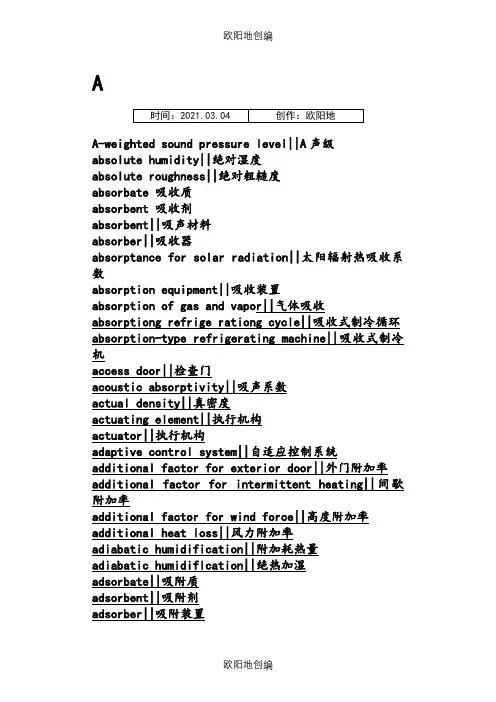
dehumidification||减湿dehumidifying cooling||减湿冷却density of dust particle||真密度derivative time||微分时间design conditions||计算参数desorption||解吸detecting element||检测元件detention period||延迟时间deviation||偏差dew-point temperature||露点温度dimond-shaped damper||菱形叶片调节阀differential pressure type flowmeter||差压流量计diffuser air supply||散流器diffuser air supply||散流器送风direct air conditioning system 直流式空气调节系统direct combustion 直接燃烧direct-contact heat exchanger 汽水混合式换热器direct digital control (DDC) system 直接数字控制系统direct evaporator 直接式蒸发器direct-fired lithiumbromide absorption-type refrigerating machine 直燃式溴化锂吸收式制冷机direct refrigerating system 直接制冷系统direct return system 异程式系统direct solar radiation 太阳直接辐射discharge pressure 排气压力discharge temperature 排气温度dispersion 大气扩散district heat supply 区域供热district heating 区域供热disturbance frequency 扰动频率dominant wind direction 最多风向double-effect lithium-bromide absorption-type refigerating machine 双效溴化锂吸收式制冷机。
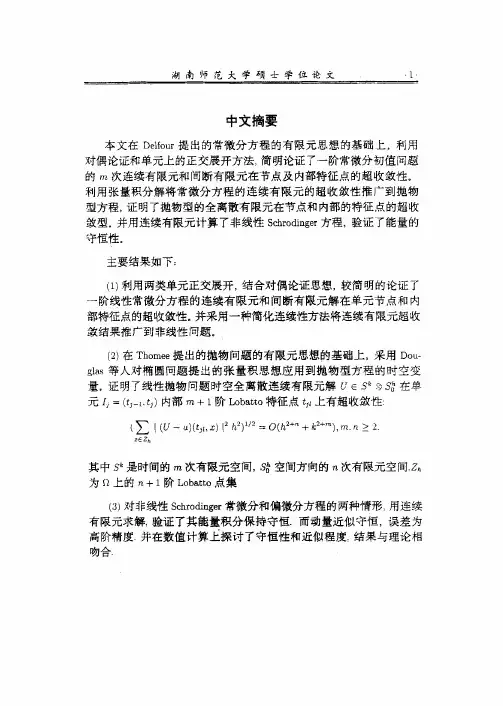
湖南师范大学硕士学位论文中文摘要本文在Delfour提出的常微分方程的有限元思想的基础上,利用对偶论证和单元上的正交展开方法,简明论证了一阶常微分初值问题的m次连续有限元和间断有限元在节点及内部特征点的超收敛性。
利用张量积分解将常微分方程的连续有限元的超收敛性推广到抛物型方程,证明了抛物型的全离散有限元在节点和内部的特征点的超收敛型。
并用连续有限元计算了非线性schrodinger方程,验证了能量的守恒性。
主要结果如下(1)利用两类单元正交展开,结合对偶论证思想,较简明的论证了一阶线性常微分方程的连续有限元和间断有限元解在单元节点和内部特征点的超收敛性。
并采用一种简化连续性方法将连续有限元超收敛结果推广到非线性问题。
(2)在Thomee提出的抛物问题的有限元思想的基础上,采用Dou—glas等人对椭圆闻题提出的张量积思想应用到抛物型方程的时空变量,证明了线性抛物问题时空全离散连续有限元解矽∈妒s珊在单元L=(t,一白)内部m十1阶Lobatto特征点。
州上有超收敛性:(∑l(u—u)(t一,工)12^2)1/2=o(^2+“+%2+”),m、n三2i∈矗其中铲是时间的m次有限元空间,醋空间方向的n次有限元空间.磊为n上的n+l阶Lobatto点集(3)对非线性schrodiⅡger常微分和偏微分方程的两种情形.用连续有限元求解,验证了其能量积分保持守恒.而动量近似守恒,误差为高阶精度.并在数值计算上探讨了守恒性和近似程度:结果与理论相吻合.湖南师范大学硕士学位论文·2性。
关键词连续有限元,抛物问题,超收敛,非线性scllrod,nger方程,守恒湖南师范大学硕士学位论文,3.AbstractBasedonchehniteelemerltidealforordinarydl丘brentialeqllationc}1at【)L()p()se(jbyDelfour,wetakeadVantage。
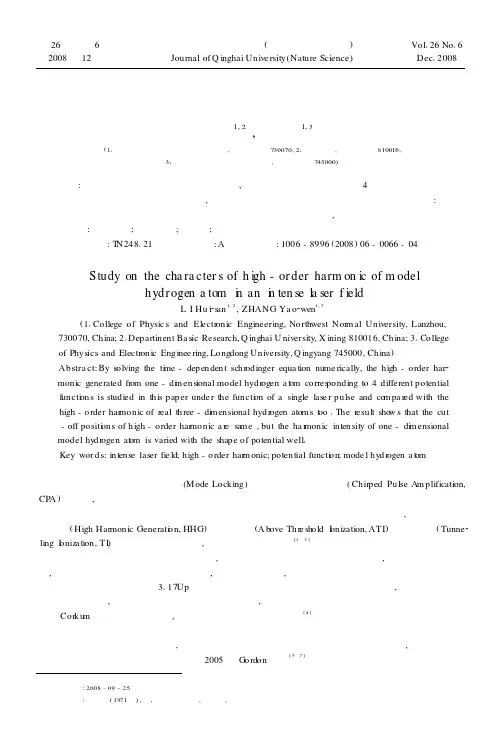
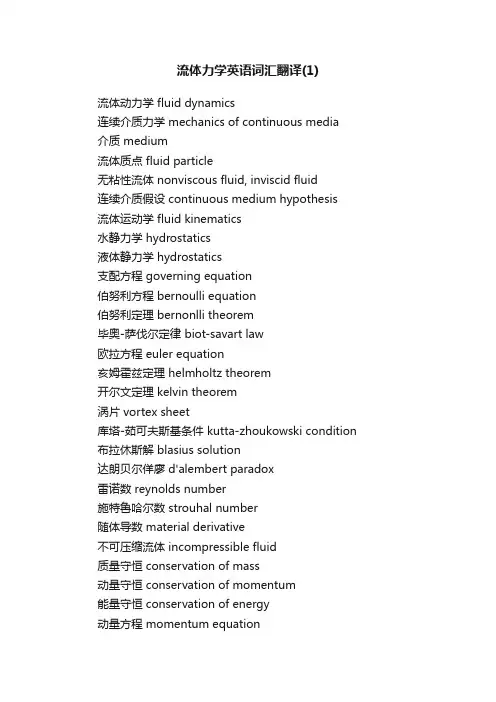
流体力学英语词汇翻译(1)流体动力学 fluid dynamics连续介质力学 mechanics of continuous media介质 medium流体质点 fluid particle无粘性流体 nonviscous fluid, inviscid fluid连续介质假设 continuous medium hypothesis流体运动学 fluid kinematics水静力学 hydrostatics液体静力学 hydrostatics支配方程 governing equation伯努利方程 bernoulli equation伯努利定理 bernonlli theorem毕奥-萨伐尔定律 biot-savart law欧拉方程 euler equation亥姆霍兹定理 helmholtz theorem开尔文定理 kelvin theorem涡片 vortex sheet库塔-茹可夫斯基条件 kutta-zhoukowski condition 布拉休斯解 blasius solution达朗贝尔佯廖 d'alembert paradox雷诺数 reynolds number施特鲁哈尔数 strouhal number随体导数 material derivative不可压缩流体 incompressible fluid质量守恒 conservation of mass动量守恒 conservation of momentum能量守恒 conservation of energy动量方程 momentum equation能量方程 energy equation控制体积 control volume液体静压 hydrostatic pressure 涡量拟能 enstrophy压差 differential pressure流[动] flow流线 stream line流面 stream surface流管 stream tube迹线 path, path line流场 flow field流态 flow regime流动参量 flow parameter流量 flow rate, flow discharge 涡旋 vortex涡量 vorticity涡丝 vortex filament涡线 vortex line涡面 vortex surface涡层 vortex layer涡环 vortex ring涡对 vortex pair涡管 vortex tube涡街 vortex street卡门涡街 karman vortex street 马蹄涡 horseshoe vortex对流涡胞 convective cell卷筒涡胞 roll cell涡 eddy涡粘性 eddy viscosity环流 circulation环量 circulation速度环量 velocity circulation偶极子 doublet, dipole驻点 stagnation point总压[力] total pressure总压头 total head静压头 static head总焓 total enthalpy能量输运 energy transport速度剖面 velocity profile库埃特流 couette flow单相流 single phase flow单组份流 single-component flow均匀流 uniform flow非均匀流 nonuniform flow二维流 two-dimensional flow三维流 three-dimensional flow准定常流 quasi-steady flow非定常流 unsteady flow, non-steady flow 暂态流 transient flow周期流 periodic flow振荡流 oscillatory flow分层流 stratified flow无旋流 irrotational flow有旋流 rotational flow轴对称流 axisymmetric flow不可压缩性 incompressibility不可压缩流[动] incompressible flow浮体 floating body定倾中心 metacenter阻力 drag, resistance减阻 drag reduction表面力 surface force表面张力 surface tension毛细[管]作用 capillarity来流 incoming flow自由流 free stream自由流线 free stream line外流 external flow进口 entrance, inlet出口 exit, outlet扰动 disturbance, perturbation分布 distribution传播 propagation色散 dispersion弥散 dispersion附加质量 added mass ,associated mass 收缩 contraction镜象法 image method无量纲参数 dimensionless parameter 几何相似 geometric similarity运动相似 kinematic similarity动力相似[性] dynamic similarity平面流 plane flow势 potential势流 potential flow速度势 velocity potential复势 complex potential复速度 complex velocity流函数 stream function源 source汇 sink速度[水]头 velocity head拐角流 corner flow空泡流 cavity flow超空泡 supercavity超空泡流 supercavity flow空气动力学 aerodynamics低速空气动力学 low-speed aerodynamics 高速空气动力学 high-speed aerodynamics 气动热力学 aerothermodynamics亚声速流[动] subsonic flow跨声速流[动] transonic flow超声速流[动] supersonic flow锥形流 conical flow楔流 wedge flow叶栅流 cascade flow非平衡流[动] non-equilibrium flow细长体 slender body细长度 slenderness钝头体 bluff body钝体 blunt body翼型 airfoil翼弦 chord薄翼理论 thin-airfoil theory构型 configuration后缘 trailing edge迎角 angle of attack失速 stall脱体激波 detached shock wave波阻 wave drag诱导阻力 induced drag诱导速度 induced velocity临界雷诺数 critical reynolds number前缘涡 leading edge vortex附着涡 bound vortex约束涡 confined vortex气动中心 aerodynamic center气动力 aerodynamic force气动噪声 aerodynamic noise气动加热 aerodynamic heating离解 dissociation地面效应 ground effect气体动力学 gas dynamics稀疏波 rarefaction wave热状态方程 thermal equation of state喷管 nozzle普朗特-迈耶流 prandtl-meyer flow瑞利流 rayleigh flow可压缩流[动] compressible flow可压缩流体 compressible fluid绝热流 adiabatic flow非绝热流 diabatic flow未扰动流 undisturbed flow等熵流 isentropic flow匀熵流 homoentropic flow兰金-于戈尼奥条件 rankine-hugoniot condition 状态方程 equation of state量热状态方程 caloric equation of state完全气体 perfect gas拉瓦尔喷管 laval nozzle马赫角 mach angle马赫锥 mach cone马赫线 mach line马赫数 mach number马赫波 mach wave当地马赫数 local mach number 冲击波 shock wave激波 shock wave正激波 normal shock wave斜激波 oblique shock wave头波 bow wave附体激波 attached shock wave 激波阵面 shock front激波层 shock layer压缩波 compression wave反射 reflection折射 refraction散射 scattering衍射 diffraction绕射 diffraction出口压力 exit pressure超压[强] over pressure反压 back pressure爆炸 explosion爆轰 detonation缓燃 deflagration水动力学 hydrodynamics液体动力学 hydrodynamics泰勒不稳定性 taylor instability盖斯特纳波 gerstner wave斯托克斯波 stokes wave瑞利数 rayleigh number自由面 free surface波速 wave speed, wave velocity 波高 wave height波列 wave train波群 wave group波能 wave energy表面波 surface wave表面张力波 capillary wave规则波 regular wave不规则波 irregular wave浅水波 shallow water wave深水波 deep water wave重力波 gravity wave椭圆余弦波 cnoidal wave潮波 tidal wave涌波 surge wave破碎波 breaking wave船波 ship wave非线性波 nonlinear wave孤立子 soliton水动[力]噪声 hydrodynamic noise 水击 water hammer空化 cavitation空化数 cavitation number空蚀 cavitation damage超空化流 supercavitating flow水翼 hydrofoil水力学 hydraulics洪水波 flood wave涟漪 ripple消能 energy dissipation海洋水动力学 marine hydrodynamics 谢齐公式 chezy formula欧拉数 euler number弗劳德数 froude number水力半径 hydraulic radius水力坡度 hvdraulic slope高度水头 elevating head水头损失 head loss水位 water level水跃 hydraulic jump含水层 aquifer排水 drainage排放量 discharge壅水曲线 back water curve压[强水]头 pressure head过水断面 flow cross-section明槽流 open channel flow孔流 orifice flow无压流 free surface flow有压流 pressure flow缓流 subcritical flow急流 supercritical flow渐变流 gradually varied flow急变流 rapidly varied flow临界流 critical flow异重流 density current, gravity flow堰流 weir flow掺气流 aerated flow含沙流 sediment-laden stream降水曲线 dropdown curve沉积物 sediment, deposit沉[降堆]积 sedimentation, deposition沉降速度 settling velocity流动稳定性 flow stability不稳定性 instability奥尔-索末菲方程 orr-sommerfeld equation 涡量方程 vorticity equation泊肃叶流 poiseuille flow奥辛流 oseen flow剪切流 shear flow粘性流[动] viscous flow层流 laminar flow分离流 separated flow二次流 secondary flow近场流 near field flow远场流 far field flow滞止流 stagnation flow尾流 wake [flow]回流 back flow反流 reverse flow射流 jet自由射流 free jet管流 pipe flow, tube flow内流 internal flow拟序结构 coherent structure猝发过程 bursting process表观粘度 apparent viscosity运动粘性 kinematic viscosity动力粘性 dynamic viscosity泊 poise厘泊 centipoise厘沱 centistoke剪切层 shear layer次层 sublayer流动分离 flow separation层流分离 laminar separation湍流分离 turbulent separation分离点 separation point附着点 attachment point再附 reattachment再层流化 relaminarization起动涡 starting vortex驻涡 standing vortex涡旋破碎 vortex breakdown涡旋脱落 vortex shedding压[力]降 pressure drop压差阻力 pressure drag压力能 pressure energy型阻 profile drag滑移速度 slip velocity无滑移条件 non-slip condition壁剪应力 skin friction, frictional drag 壁剪切速度 friction velocity磨擦损失 friction loss磨擦因子 friction factor耗散 dissipation滞后 lag相似性解 similar solution局域相似 local similarity气体润滑 gas lubrication液体动力润滑 hydrodynamic lubrication 浆体 slurry泰勒数 taylor number纳维-斯托克斯方程 navier-stokes equation 牛顿流体 newtonian fluid边界层理论 boundary later theory边界层方程 boundary layer equation边界层 boundary layer附面层 boundary layer层流边界层 laminar boundary layer湍流边界层 turbulent boundary layer温度边界层 thermal boundary layer边界层转捩 boundary layer transition边界层分离 boundary layer separation边界层厚度 boundary layer thickness位移厚度 displacement thickness。
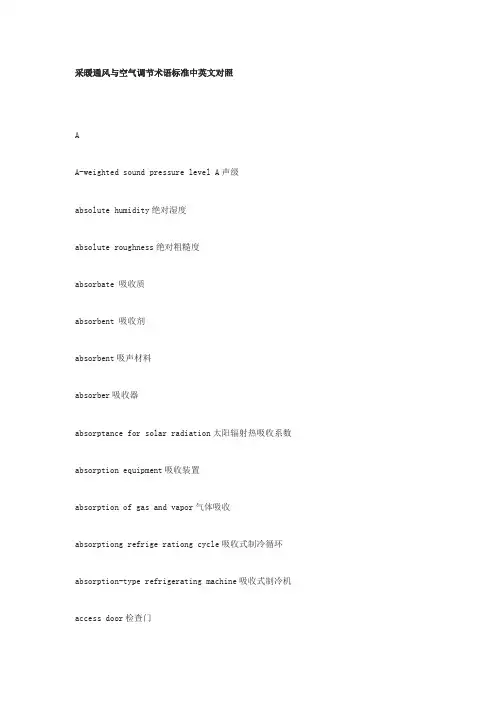
采暖通风与空气调节术语标准中英文对照AA-weighted sound pressure level A声级absolute humidity绝对湿度absolute roughness绝对粗糙度absorbate 吸收质absorbent 吸收剂absorbent吸声材料absorber吸收器absorptance for solar radiation太阳辐射热吸收系数absorption equipment吸收装置absorption of gas and vapor气体吸收absorptiong refrige rationg cycle吸收式制冷循环absorption-type refrigerating machine吸收式制冷机access door检查门acoustic absorptivity吸声系数actual density真密度actuating element执行机构actuator执行机构adaptive control system自适应控制系统additional factor for exterior door外门附加率additional factor for intermittent heating间歇附加率additional factor for wind force高度附加率additional heat loss风力附加率adiabatic humidification附加耗热量adiabatic humidiflcation绝热加湿adsorbate吸附质adsorbent吸附剂adsorber吸附装置adsorption equipment吸附装置adsorption of gas and vapor气体吸附aerodynamic noise空气动力噪声aerosol气溶胶air balance风量平衡air changes换气次数air channel风道air cleanliness空气洁净度air collector集气罐air conditioning空气调节air conditioning condition空调工况air conditioning equipment空气调节设备air conditioning machine room空气调节机房air conditioning system空气调节系统air conditioning system cooling load空气调节系统冷负荷air contaminant空气污染物air-cooled condenser风冷式冷凝器air cooler空气冷却器air curtain空气幕air cushion shock absorber空气弹簧隔振器air distribution气流组织air distributor空气分布器air-douche unit with water atomization喷雾风扇air duct风管、风道air filter空气过滤器air handling equipment空气调节设备air handling unit room空气调节机房air header集合管air humidity空气湿度air inlet风口air intake进风口air manifold集合管air opening风口air pollutant空气污染物air pollution大气污染air preheater空气预热器air return method回风方式air return mode回风方式air return through corridor走廊回风air space空气间层air supply method送风方式air supply mode送风方式air supply (suction) opening with slide plate插板式送(吸)风口air supply volume per unit area单位面积送风量air temperature空气温度air through tunnel地道风air-to-air total heat exchanger全热换热器air-to-cloth ratio气布比air velocity at work area作业地带空气流速air velocity at work place工作地点空气流速air vent放气阀air-water systen空气—水系统airborne particles大气尘air hater空气加热器airspace空气间层alarm signal报警信号ail-air system全空气系统all-water system全水系统allowed indoor fluctuation of temperature and relative humidity室内温湿度允许波动范围ambient noise环境噪声ammonia氨amplification factor of centrolled plant调节对象放大系数amplitude振幅anergy@angle of repose安息角ange of slide滑动角angle scale热湿比angle valve角阀annual [value]历年值annual coldest month历年最冷月annual hottest month历年最热月anticorrosive缓蚀剂antifreeze agent防冻剂antifreeze agent防冻剂apparatus dew point机器露点apparent density堆积密度aqua-ammonia absorptiontype-refrigerating machine氨—水吸收式制冷机aspiation psychrometer通风温湿度计Assmann aspiration psychrometer通风温湿度计atmospheric condenser淋激式冷凝器atmospheric diffusion大气扩散atmospheric dust大气尘atmospheric pollution大气污染atmospheric pressure大气压力(atmospheric stability大气稳定度atmospheric transparency大气透明度atmospheric turblence大气湍流automatic control自动控制automatic roll filter自动卷绕式过滤器automatic vent自动放气阀available pressure资用压力average daily sol-air temperature日平均综合温度axial fan轴流式通风机azeotropic mixture refrigerant共沸溶液制冷剂Bback-flow preventer防回流装置back pressure of steam trap凝结水背压力back pressure return余压回水background noise背景噪声back plate挡风板bag filler袋式除尘器baghouse袋式除尘器barometric pressure大气压力basic heat loss基本耗热量hend muffler消声弯头bimetallic thermometer双金属温度计black globe temperature黑球温度blow off pipe排污管blowdown排污管boiler锅炉boiller house锅炉房boiler plant锅炉房boiler room锅炉房booster加压泵branch支管branch duct(通风) 支管branch pipe支管building envelope围护结构building flow zones建筑气流区building heating entry热力入口bulk density堆积密度bushing补心butterfly damper蝶阀by-pass damper空气加热器〕旁通阀by-pass pipe旁通管Ccanopy hood 伞形罩capillary tube毛细管capture velocity控制风速capture velocity外部吸气罩capturing hood 卡诺循环Carnot cycle串级调节系统cascade control system铸铁散热器cast iron radiator催化燃烧catalytic oxidation 催化燃烧ceilling fan吊扇ceiling panelheating顶棚辐射采暖center frequency中心频率central air conditionint system 集中式空气调节系统central heating集中采暖central ventilation system新风系统centralized control集中控制centrifugal compressor离心式压缩机entrifugal fan离心式通风机check damper(通风〕止回阀check valve止回阀chilled water冷水chilled water system with primary-secondary pumps一、二次泵冷水系统chimney(排气〕烟囱circuit环路circulating fan风扇circulating pipe循环管circulating pump循环泵clean room洁净室cleaning hole清扫孔cleaning vacuum plant真空吸尘装置cleanout opening清扫孔clogging capacity容尘量close nipple长丝closed booth大容积密闭罩closed full flow return闭式满管回水closed loop control闭环控制closed return闭式回水closed shell and tube condenser卧式壳管式冷凝器closed shell and tube evaporator卧式壳管式蒸发器closed tank闭式水箱coefficient of accumulation of heat蓄热系数coefficient of atmospheric transpareney大气透明度coefficient of effective heat emission散热量有效系数coficient of effective heat emission传热系数coefficient of locall resistance局部阻力系数coefficient of thermal storage蓄热系数coefficient of vapor蒸汽渗透系数coefficient of vapor蒸汽渗透系数coil盘管collection efficiency除尘效率combustion of gas and vapor气体燃烧comfort air conditioning舒适性空气调节common section共同段compensator补偿器components(通风〕部件compression压缩compression-type refrigerating machine压缩式制冷机compression-type refrigerating system压缩式制冷系统compression-type refrigeration压缩式制冷compression-type refrigeration cycle压缩式制冷循环compression-type water chiller压缩式冷水机组concentratcd heating集中采暖concentration of narmful substance有害物质浓度condensate drain pan凝结水盘condensate pipe凝结水管condensate pump凝缩水泵condensate tank凝结水箱condensation冷凝condensation of vapor气体冷凝condenser冷凝器condensing pressure冷凝压力condensing temperature冷凝温度condensing unit压缩冷凝机组conditioned space空气调节房间conditioned zone空气调节区conical cowl锥形风帽constant humidity system恒湿系统constant temperature and humidity system恒温恒湿系统constant temperature system 恒温系统constant value control 定值调节constant volume air conditioning system定风量空气调节系统continuous dust dislodging连续除灰continuous dust dislodging连续除灰continuous heating连续采暖contour zone稳定气流区control device控制装置control panel控制屏control valve调节阀control velocity控制风速controlled natural ventilation有组织自然通风controlled plant调节对象controlled variable被控参数controller调节器convection heating对流采暖convector对流散热器cooling降温、冷却(、)cooling air curtain冷风幕cooling coil冷盘管cooling coil section冷却段cooling load from heat传热冷负荷cooling load from outdoor air新风冷负荷cooling load from ventilation新风冷负荷cooling load temperature冷负荷温度cooling system降温系统cooling tower冷却塔cooling unit冷风机组cooling water冷却水correcting element调节机构correcting unit执行器correction factor for orientaion朝向修正率corrosion inhibitor缓蚀剂coupling管接头cowl伞形风帽criteria for noise control cross噪声控频标准cross fan四通crross-flow fan贯流式通风机cross-ventilation穿堂风cut diameter分割粒径cyclone旋风除尘器cyclone dust separator旋风除尘器cylindrical ventilator筒形风帽Ddaily range日较差damping factot衰减倍数data scaning巡回检测days of heating period采暖期天数deafener消声器decibel(dB)分贝degree-days of heating period采暖期度日数degree of subcooling过冷度degree of superheat过热度dehumidification减湿dehumidifying cooling减湿冷却density of dust particle真密度derivative time微分时间design conditions计算参数desorption解吸detecting element检测元件detention period延迟时间deviation偏差dew-point temperature露点温度dimond-shaped damper菱形叶片调节阀differential pressure type flowmeter差压流量计diffuser air supply散流器diffuser air supply散流器送风direct air conditioning system 直流式空气调节系统direct combustion 直接燃烧direct-contact heat exchanger 汽水混合式换热器direct digital control (DDC) system 直接数字控制系统direct evaporator 直接式蒸发器direct-fired lithiumbromide absorption-type refrigerating machine 直燃式溴化锂吸收式制冷机direct refrigerating system 直接制冷系统direct return system 异程式系统direct solar radiation 太阳直接辐射discharge pressure 排气压力discharge temperature 排气温度dispersion 大气扩散district heat supply 区域供热district heating 区域供热disturbance frequency 扰动频率dominant wind direction 最多风向double-effect lithium-bromide absorption-type refigerating machine 双效溴化锂吸收式制冷机double pipe condenser 套管式冷凝器down draft 倒灌downfeed system 上分式系统downstream spray pattern 顺喷drain pipe 泄水管drain pipe 排污管droplet 液滴drv air 干空气dry-and-wet-bulb thermometer 干湿球温度表dry-bulb temperature 干球温度dry cooling condition 干工况dry dust separator 干式除尘器dry expansion evaporator 干式蒸发器dry return pipe 干式凝结水管dry steam humidifler 干蒸汽加湿器dualductairconing ition 双风管空气调节系统dual duct system 双风管空气调节系统duct 风管、风道dust 粉尘dust capacity 容尘量dust collector 除尘器dust concentration 含尘浓度dust control 除尘dust-holding capacity 容尘量dust removal 除尘dust removing system 除尘系统dust sampler 粉尘采样仪dust sampling meter 粉尘采样仪dust separation 除尘dust separator 除尘器dust source 尘源dynamic deviation动态偏差Eeconomic resistance of heat transfer经济传热阻economic velocity经济流速efective coefficient of local resistance折算局部阻力系数effective legth折算长度effective stack height烟囱有效高度effective temperature difference送风温差ejector喷射器ejetor弯头elbow电加热器electric heater电加热段electric panel heating电热辐射采暖electric precipitator电除尘器electricradian theating 电热辐射采暖electricresistance hu-midkfier电阻式加湿器electro-pneumatic convertor电—气转换器electrode humidifler电极式加湿器electrostatic precipi-tator电除尘器eliminator挡水板emergency ventilation事故通风emergency ventilation system事故通风系统emission concentration排放浓度enclosed hood密闭罩enthalpy焓enthalpy control system新风〕焓值控制系统enthalpy entropy chart焓熵图entirely ventilation全面通风entropy熵environmental noise环境噪声equal percentage flow characteristic等百分比流量特性equivalent coefficient of local resistance当量局部阻力系数equivalent length当量长度equivalent[continuous A] sound level等效〔连续A〕声级evaporating pressure蒸发压力evaporating temperature蒸发温度evaporative condenser蒸发式冷凝器evaporator蒸发器excess heat余热excess pressure余压excessive heat 余热cxergy@exhaust air rate排风量exhaust fan排风机exhaust fan room排风机室exhaust hood局部排风罩exhaust inlet吸风口exhaust opening吸风口exhaust opening orinlet风口exhaust outlet排风口exaust vertical pipe排气〕烟囱exhausted enclosure密闭罩exit排风口expansion膨胀expansion pipe膨胀管explosion proofing防爆expansion steam trap恒温式疏水器expansion tank膨胀水箱extreme maximum temperature极端最高温度extreme minimum temperature极端最低温度Ffabric collector袋式除尘器face tube皮托管face velocity罩口风速fan通风机fan-coil air-conditioning system风机盘管空气调节系统fan-coil system风机盘管空气调节系统fan-coil unit风机盘管机组fan house通风机室fan room通风机室fan section风机段feed-forward control前馈控制feedback反馈feeding branch tlo radiator散热器供热支管fibrous dust纤维性粉尘fillter cylinder for sampling滤筒采样管fillter efficiency过滤效率fillter section过滤段filltration velocity过滤速度final resistance of filter过滤器终阻力fire damper防火阀fire prevention防火fire protection防火fire-resisting damper防火阀fittings(通风〕配件fixed set-point control定值调节fixed support固定支架fixed time temperature (humidity)定时温(湿)度flame combustion热力燃烧flash gas闪发气体flash steam二次蒸汽flexible duct软管flexible joint柔性接头float type steam trap浮球式疏水器float valve浮球阀floating control无定位调节flooded evaporator满液式蒸发器floor panel heating地板辐射采暖flow capacity of control valve调节阀流通能力flow characteristic of control valve调节阀流量特性foam dust separator泡沫除尘器follow-up control system随动系统forced ventilation机械通风forward flow zone射流区foul gas不凝性气体four-pipe water system四管制水系统fractional separation efficiency分级除尘效率free jet自由射流free sillica游离二氧化硅free silicon dioxide游离二氧化硅freon氟利昂frequency interval频程frequency of wind direction风向频率fresh air handling unit新风机组resh air requirement新风量friction factor摩擦系数friction loss摩擦阻力frictional resistance摩擦阻力fume烟〔雾〕fumehood排风柜fumes烟气Ggas-fired infrared heating 煤气红外线辐射采暖gas-fired unit heater 燃气热风器gas purger 不凝性气体分离器gate valve 闸阀general air change 全面通风general exhaust ventilation (GEV) 全面排风general ventilation 全面通风generator 发生器global radiation总辐射grade efficiency分级除尘效率granular bed filter颗粒层除尘器granulometric distribution粒径分布gravel bed filter颗粒层除尘器gravity separator沉降室ground-level concentration落地浓度guide vane导流板Hhair hygrometor毛发湿度计hand pump手摇泵harmful gas andvapo有害气体harmful substance有害物质header分水器、集水器(、)heat and moisture热湿交换transfer热平衡heat conduction coefficient导热系数heat conductivity导热系数heat distributing network热网heat emitter散热器heat endurance热稳定性heat exchanger换热器heat flowmeter热流计heat flow rate热流量heat gain from lighting设备散热量heat gain from lighting照明散热量heat gain from occupant人体散热量heat insulating window保温窗heat(thermal)insuation隔热heat(thermal)lag延迟时间heat loss耗热量heat loss by infiltration冷风渗透耗热量heat-operated refrigerating system热力制冷系统heat-operated refrigetation热力制冷heat pipe热管heat pump热泵heat pump air conditioner热泵式空气调节器heat release散热量heat resistance热阻heat screen隔热屏heat shield隔热屏heat source热源heat storage蓄热heat storage capacity蓄热特性heat supply供热heat supply network热网heat transfer传热heat transmission传热heat wheel转轮式换热器heated thermometer anemometer热风速仪heating采暖、供热、加热(、、)heating appliance采暖设备heating coil热盘管heating coil section加热段heating equipment采暖设备heating load热负荷heating medium热媒heating medium parameter热媒参数heating pipeline采暖管道heating system采暖系统heavy work重作业high-frequency noise高频噪声high-pressure ho twater heating高温热水采暖high-pressure steam heating高压蒸汽采暖high temperature water heating高温热水采暖hood局部排风罩horizontal water-film syclonet卧式旋风水膜除尘器hot air heating热风采暖hot air heating system热风采暖系统hot shop热车间hot water boiler热水锅炉hot water heating热水采暖hot water system热水采暖系统hot water pipe热水管hot workshop热车间hourly cooling load逐时冷负荷hourly sol-air temperature逐时综合温度humidification加湿humidifier加湿器humididier section加湿段humidistat恒湿器humidity ratio含湿量hydraulic calculation水力计算hydraulic disordeer水力失调hydraulic dust removal水力除尘hydraulic resistance balance阻力平衡hydraulicity水硬性hydrophilic dust亲水性粉尘hydrophobic dust疏水性粉尘Iimpact dust collector冲激式除尘器impact tube皮托管impedance muffler阻抗复合消声器inclined damper斜插板阀index circuit最不利环路indec of thermal inertia (valueD)热惰性指标(D值)indirect heat exchanger表面式换热器indirect refrigerating sys间接制冷系统indoor air design conditions室内在气计算参数indoor air velocity室内空气流速indoor and outdoor design conditions室内外计算参数indoor reference for air temperature and relative humidity室内温湿度基数indoor temperature (humidity)室内温(湿)度induction air-conditioning system诱导式空气调节系统induction unit诱导器inductive ventilation诱导通风industral air conditioning工艺性空气调节industrial ventilation工业通风inertial dust separator惯性除尘器infiltration heat loss冷风渗透耗热量infrared humidifier红外线加湿器infrared radiant heater红外线辐射器inherent regulation of controlled plant调节对象自平衡initial concentration of dust初始浓度initial resistance of filter过滤器初阻力imput variable输入量insulating layer保温层integral enclosure整体密闭罩integral time积分时间interlock protection联锁保护intermittent dust removal定期除灰intermittent heating间歇采暖inversion layer逆温层inverted bucket type steam trap倒吊桶式疏水器irradiance辐射照度isoenthalpy等焓线isobume等湿线isolator隔振器isotherm等温线isothermal humidification等温加湿isothermal jet等温射流Jjet射流jet axial velocity射流轴心速度jet divergence angle射流扩散角jet in a confined space受限射流Kkatathermometer卡他温度计Llaboratory hood排风柜lag of controlled plant调节对象滞后large space enclosure大容积密闭罩latent heat潜热lateral exhaust at the edge of a bath槽边排风罩lateral hoodlength of pipe section侧吸罩length of pipe section管段长度light work轻作业limit deflection极限压缩量limit switch限位开关limiting velocity极限流速linear flow characteristic线性流量特性liquid-level gage液位计liquid receiver贮液器lithium bromide溴化锂lithium-bromide absorption-type refrigerating machine溴化锂吸收式制冷机lithium chloride resistance hygrometer氯化锂电阻湿度计load pattern负荷特性local air conditioning局部区域空气调节local air suppiy system局部送风系统local exhaustventilation (LEV)局部排风local exhaust system局部排风系统local heating局部采暖local relief局部送风local relief system局部送风系统local resistance局部阻力local solartime地方太阳时local ventilation局部通风local izedairsupply for air-heating集中送风采暖local ized air control就地控制loop环路louver百叶窗low-frequencynoise低频噪声low-pressure steam heating低压蒸汽采暖lyophilic dust亲水性粉尘lyophobic dust疏水性粉尘Mmain 总管、干管main duct通风〕总管、〔通风〕干管main pipe总管、干管make-up water pump补给水泵manual control手动控制mass concentration质量浓度maximum allowable concentration (MAC)最高容许浓度maximum coefficient of heat transfer最大传热系数maximum depth of frozen ground最大冻土深度maximum sum of hourly colling load逐时冷负荷综合最大值mean annual temperature (humidity)年平均温(湿)度mean annual temperature (humidity)日平均温(湿)度mean daily temperature (humidity)旬平均温(湿)度mean dekad temperature (humidity)月平均最高温度mean monthly maximum temperature月平均最低温度mean monthly minimum temperature月平均湿(湿)度mean monthly temperature (humidity)平均相对湿度mean relative humidity平均风速emchanical air supply system机械送风系统mechanical and hydraulic联合除尘combined dust removal机械式风速仪mechanical anemometer机械除尘mechanical cleaning off dust机械除尘mechanical dust removal机械排风系统mechanical exhaust system机械通风系统mechanical ventilation机械通风media velocity过滤速度metal radiant panel金属辐射板metal radiant panel heating金属辐射板采暖micromanometer微压计micropunch plate muffler微穿孔板消声器mid-frequency noise中频噪声middle work中作业midfeed system中分式系统minimum fresh air requirmente最小新风量minimum resistance of heat transfer最小传热阻mist雾mixing box section混合段modular air handling unit组合式空气调节机组moist air湿空气moisture excess余湿moisure gain散湿量moisture gain from appliance and equipment设备散湿量moisturegain from occupant人体散湿量motorized valve电动调节阀motorized (pneumatic)电(气)动两通阀-way valvemotorized (pneumatic)-way valve电(气)动三通阀movable support活动支架muffler消声器muffler section消声段multi-operating mode automtic conversion工况自动转换multi-operating mode control system多工况控制系统multiclone多管〔旋风〕除尘器multicyclone多管〔旋风〕除尘器multishell condenser组合式冷凝器Nnatural and mechanical combined ventilation联合通风natural attenuation quantity of noise噪声自然衰减量natural exhaust system自然排风系统natural freguency固有频率natural ventilation自然通风NC-curve[s]噪声评价NC曲线negative freedback负反馈neutral level中和界neutral pressure level中和界neutral zone中和界noise噪声noise control噪声控制noise criter ioncurve(s)噪声评价NC曲线noisc rating number噪声评价NR曲线noise reduction消声non azeotropic mixture refragerant非共沸溶液制冷剂non-commonsection非共同段non condensable gas 不凝性气体non condensable gas purger不凝性气体分离器non-isothermal jet非等温射流nonreturn valve通风〕止回阀normal coldest month止回阀normal coldest month累年最冷月normal coldest -month period累年最冷三个月normal hottest month累年最热月(3)normal hottest month period累年最热三个月normal three summer months累年最热三个月normal three winter months累年最冷三个月normals累年值nozzle outlet air suppluy喷口送风number concentration计数浓度number of degree-day of heating period采暖期度日数Ooctave倍频程/ octave倍频程octave band倍频程oil cooler油冷却器oill-fired unit heater燃油热风器one-and-two pipe combined heating system单双管混合式采暖系统one (single)-pipe circuit (cross-over) heating system单管跨越式采暖系统one(single)-pipe heating system单管采暖系统pne(single)-pipe loop circuit heating system水平单管采暖系统one(single)-pipe seriesloop heating system单管顺序式采暖系统one-third octave band倍频程on-of control双位调节open loop control开环控制open return开式回水open shell and tube condenser立式壳管式冷凝器open tank开式水箱operating pressure工作压力operating range作用半径opposed multiblade damper对开式多叶阀organized air supply有组织进风organized exhaust有组织排风organized natural ventilation有组织自然通风outdoor air design conditions室外空气计算参数outdoor ctitcal air temperature for heating采暖室外临界温度outdoor design dry-bulb temperature for summer air conlitioning夏季空气调节室外计算干球温度outdoor design hourly temperature for summer air conditioning夏季空气调节室外计算逐时温度outdoor design mean daily temperature for summer air conditioning夏季空气调节室外计算日平均温度outdoor design relative humidityu for summer ventilation夏季通风室外计算相对湿度outdoor design relative humidity for winter air conditioning冬季空气调节室外计算相对湿度outdoor design temperature ture for calculated envelope in winter冬季围护结构室外计算温度outdoor design temperature ture for heating采暖室外计算温度outdoor design temperature for summer ventilation夏季通风室外计算温度outdoor design temperature for winter air conditioning冬季空气调节室外计算温度outdoor design temperature for winter vemtilation冬季通风室外计算温度outdoor designwet-bulb temperature for summer air conditioning夏季空气调节室外计算湿球温度outdoor mean air temperature during heating period采暖期室外平均温度outdoor temperature(humidity)室外温(湿)度outlet air velocity出口风速out put variable输出量overall efficiency of separation除尘效率overall heat transmission coefficient传热系数ouvrflow pipe溢流管overheat steam过热蒸汽overlapping averages滑动平均overshoot超调量Ppackaged air conditioner整体式空气调节器。


专利名称:Apparatus for the continuous ordiscontinuous production of bitumen coatedproducts with aggregates and bitumen发明人:MARCONNET, GUY LA CHAMPAGNIERE申请号:EP91400317.3申请日:19910208公开号:EP0442790A1公开日:19910821专利内容由知识产权出版社提供专利附图:摘要:Cold and wet aggregates (4) are continuously introduced into a drying zone (7).The aggregates and hot gases are circulated countercurrentwise in the drying zone (7).The dried and heated aggregates are continuously introduced into a mixing zone (16) through which the hot gases do not travel. Liquid bitumen is incorporated into the aggregates in the mixing zone (16). The aggregates are circulated and they are mixed with the bitumen during their circulation in the mixing zone (16). During coating, the aggregates are kept in the mixing zone (16) during certain phases at least of production, by closure of a discharge means (21) communicating with the exit from the mixing zone (16).申请人:ERMONT. C.M.地址:RUE JEAN-PIERRE TIMBAUD; F-42420 LORETTE,Rue Jean-Pierre Timbaud F-42420 Lorette FR国籍:FR代理机构:Bouget, Lucien更多信息请下载全文后查看。
a r X i v :q u a n t -p h /9708011v 1 6 A u g 1997Continuous stochastic Schr¨o dinger equations and localizationM.Rigo,F.Mota-Furtado and P.F.O’Mahony Department of Mathematics,Royal Holloway,University of London,Egham,Surrey TW200EX,UK Abstract.The set of continuous norm-preserving stochastic Schr¨o dinger equations associated with the Lindblad master equation is introduced.This set is used to describe the localization properties of the state vector toward eigenstates of the environment operator.Particular focus is placed on determining the stochastic equation which exhibits the highest rate of localization for wide open systems.An equation having such a property is proposed in the case of a single non-hermitian environment operator.This result is relevant to numerical simulations of quantum trajectories where localization properties are used to reduce the number of basis states needed to represent the system state,and thereby increase the speed of calculation.1.Introduction A quantum system interacting with its environment can be described,in the Markovian approximation,by two complementary approaches.In the first and most commonly used [1,2,3],the system is represented by a density operator and its evolution is described bya master equation.In the second a state vector represents the system and a stochastic Schr¨o dinger equation describes the state evolution [4,5,6]These two treatments are equivalent in the following sense:for all times an ensemble of state vectors generated by a stochastic Schr¨o dinger equation reproduces,on average,the density operator generated by the master equation.The correspondence is not uniquely defined,in that for a single master equation there are many associated stochastic equations.Stochastic state vector equations,also called unravelings of the master equation,have been introduced in different contexts and with different interpretations.In the fundamental theory of quantum measurement,stochastic equations have been used to describe the general dynamical process of the state collapse into an eigenstate of the measured observable,i.e.localization [4,7,8,9,10,11,12,13].In quantum optics,stochastic Schr¨o dinger equations have been used to describe the system state conditioned by measurement outcomes.In this context,an unraveling corresponds to2a specified measurement scheme,such as photon counting,heterodyne or homodyne detection[6,14].More generally,in thefield of open quantum systems,unravelings have been used as an efficient numerical method to solve the master equation [15,16,17,18,19,20,21,22,23,24,25,26].The present work is motivated by a recent study of a quantum system in interaction with a thermal bath using the quantum jump(QJ)unraveling[27].It is shown that,under some assumptions valid in the classical limit,the QJ trajectories,i.e.,the realization of the stochastic process,approach a diffusive limit very similar to the one exhibited by the quantum state diffusion(QSD)trajectories.Since diffusion is expected to be a general feature associated with the emergence of classicality,a description of the whole set of continuous unravelings becomes important.This set is introduced in a unified way in the following section.We will show that each continuous unraveling can be characterized very simply by specifying its noise correlations.The set of continuous unravelings is then used to study how quantum state properties,such as localization, evolve when the unraveling changes.A very important characteristic of quantum trajectories which has both physical and numerical consequences is the localization of quantum states toward eigenstates of the environment operator.Working with the real noise unraveling(RN),Gisin[7]has shown that for an arbitrary hermitian Lindblad operator L the state vectors concentrate on the eigenspace of L.Percival[9]extended this result by giving a proper definition of the ensemble localization of an arbitrary operator and then providing analytical bounds for the rate of self-localization of hermitian and nonhermitian Lindblad operators for the quantum state diffusion unraveling.For a dissipative interaction,Garraway and Knight [28,29]have presented numerical simulations of the localization process using the QJ and QSD unravelings.Starting from different quantum states,such as a superposition of two coherent states,a Fock state and a squeezed ground state,they have shown that such states are highly sensitive to dissipation.They also illustrated the localization process. Recently they have applied their results to describe the evolution of a Schr¨o dinger cat state in a Kerr medium where localization competes with nonlinear effects[30](see also [31]).For numerical simulation of open quantum systems,individual trajectories have proven advantageous over density operator computations.The main advantages stem from the fact that less space is needed to store and propagate in time a state vector than a density matrix.In addition,for trajectory methods one can exploit the localization property to reduce the number of basis states needed to represent the state vector,thus significantly reducing the time needed to calculate quantum trajectories.For quantum jump unravelings,when many Lindblad operators are present,it is well known that one can perform a unitary transformation to select one of the quantum jumps unravelings, in such a way as to minimize the number of basis states needed(see ref.[22]for an3 application of this property).The localization of the state vector for QSD has been exploited in the mixed representation of Steimle and al.[23]and the moving basis of Schack and al.[24,25,26].In section3we use the set of continuous unravelings to describe localization properties for a single environment operator.Several well known results are recovered for a hermitian operator[4,32].In the case of a non-hermitian operator the minimal rate of localization introduced for the QSD unraveling[9,11,12]is extended to the complete set showing that localization is a general feature shared by all the continuous unravelings, and a new unraveling is introduced.Some theoretical arguments supported by numerical simulations suggest that this new unraveling possesses the highest localization rate.In the present work we make use of the freedom of choice for the noise correlations to obtain the continuous unraveling which localizes the state vector the most.This transformation should not be confused with the unitary transformation discussed above. These two transformations are complementary and can be used together.At the end of section3we compare the localization properties of QSD and of our proposed unraveling.Finally,in section4we summarize our results and draw conclusions about the applicability of the set of continuous unravelings to the study of the quasi-classical limit of open quantum systems.2.Continuous unravelingsWe proceed following closely the derivation of the quantum state diffusion unraveling by Gisin and Percival[8].In this work,a general stochastic differential equation with a complex Wiener process is used as a starting point.The drift and noise terms are then specified by asking that the stochastic differential equation recovers on average the Lindblad master equation for the density operatorρof the system˙ρ=−i2{L†j L j,ρ},(1)where H is the system Hamiltonian and L j(j=1,...,J)the set of Lindblad operators which represent the influence of the environment.(Since the master equation(1)is valid under a Markovian approximation,all the stochastic differential equations considered apply only within this approximation).The other conditions needed to specify the drift and noise terms are that the state remains normalized and that the stochastic equation shares the same invariance properties under unitary transformations as the master equation.This last constraint is used to prove the uniqueness of QSD among the set of continuous unravelings.Removing the constraint of invariance under unitary transformations among the Lindblad operators,we obtain the set of continuous norm-preserving unravelings related to the master equation.42.1.Derivation of the stochastic Schr¨o dinger equationsWe start by considering a general stochastic differential equation of the following Itˆo form which gives the variation |dψ of the state vector |ψ in a time dt|dψ =|v dt +J j =1|u j N n =1αjn dW jn (2)where |v and |u j are vectors,αjn are complex numbers and dW jn independent real Wiener processes [33]which obey the following relationshipsM (dW jn )=0dW jn dW km =δjk δmn dt dW jn dt =0(3)where M represents the ensemble average.The two conditions to be respected by the previous equation (2)are (i )the state is normalized for all times ψ|ψ t =1and (ii )for each time,the mean of the projector associated to the state |ψ gives the density matrix ρ=M (|ψ ψ|)with the density matrix ρevolving according to the master equation in Lindblad form (1).In the following,these two conditions will be used to relate the drift term |v and the stochastic term |u j to the state |ψ as well as giving constraints on the complex numbers αjn .Notice that the αjn may also depend on the state |ψ and on time t .By following closely the QSD derivation given in reference [8],we obtain the expression for the drift term|v =−i2 j L †j L j + L †j ψ L j ψ−2 L †j ψL j |ψ (4)where L j ψ= ψ|L j |ψ is the expectation value of L j for the state |ψ .The drift term |v is the same as that obtained in the QSD derivation,but the stochastic vectors |u j become |u j =1 n |αjn |2 k βjk (L k − L k ψ)|ψ j =1...J (5)which differs from the QSD derivation by the introduction of the normalization factor ( n |αjn |2)−1/2and the set of complex numbers βjk .The latter are arbitrary coefficients of a J ×J unitary matrix which arises due to the freedom of choice in the linear combination of vectors (L k − L k ψ)|ψ used to express |u j .Finally one gets the equation for the state vector increment|dψ =−i 2J j =1L †j L j + L †j ψ L j ψ−2 L †j ψL j |ψ dt +J k =1(L k − L k ψ)|ψ dζk(6)5 This equation shows that all the indeterminacy due to the coefficientsαjn and to the unitary transformation(βjk)can be included in the noise terms dζj which are given bydζk=Jj=1βjk nαjn dW jnn|αjn|2(7)It can be seen easily that they have zero mean M(dζj)=0and correlationsdζj dζ∗k=δjk dt and dζj dζk=c jk dt(8) where c jk are correlation coefficients related to the unitary transformation(βjk)and the noise coefficientsαin in the following wayc jk=Ji=1βijβik c i with c i= nα2in2for all j.In this special case the correlations c jk vanish.2.2.Unitary transformationLet us introduce the following unitary transformation among Lindblad operators L j= k u jk˜L k−λj11(10)6where u jk and λj are complex numbers and (u jk )a unitary matrix [8,9,35].With this transformation the noise terms become d ˜ζk = j u jk dζj with the correlations d ˜ζj d ˜ζ∗k =δjk dt and d ˜ζj d ˜ζk =J m,n =1u mj u nk c mn dt (11)These correlations will depend on the unitary transformation (u jk )unless all the correlation factors vanish,i.e.c jk =0.Since (βjk )is itself a unitary transformation,a necessary condition for invariance under unitary transformation is given byc j =0for all j =1,...,J.(12)When only one Wiener process N =1is present,the unitary invariance condition (12)implies αj 1=0for all j .As a consequence there is no invariant unraveling with only one Wiener process.With two Wiener processes N =2,the invariance condition becomes α2j 1+α2j 2=0.The norm of the two complex numbers is the same |αj 1|=|αj 2|and the phases are related by φj 1−φj 2=π/2+nπwhere n is any integer number.The simplest case n =0leads todζj =e iφj dW j 1+idW j 22 (13)which correspond to the complex noise used in the QSD unraveling when the phases φj are set to zero.The simplest case which can satisfy the invariance condition (12)is given by the QSD unraveling.The phases φj and other choices of n introduce only irrelevant phase factors which can be neglected.This is the uniqueness result of Gisin and Percival for QSD.If one considers more than two Wiener processes N ≥3,it is possible to construct other unravelings invariant under unitary transformation.For instance:dζ=dW 1+e iπ/3dW 2+e −iπ/3dW 33(14)where we have omitted the index j and the phase factor.Since all these unravelings have the same correlations dζ2=0and |dζ|2=dt ,they are equivalent [33]and can be replaced by the QSD unraveling.3.LocalizationAs an application of the set of continuous unraveling obtained in the present work,one can compute the rate of self-localization of a single environment operator L for a wide open system,i.e.H =0,and determine the effect of the noise correlation on the rate of self-localization.The rate of self-localization is defined as the rate at which the ensemble average of the quantum mean square deviation decays [9].It is also the7 ensemble average rate at which the state vector|ψ tends towards one of the(right-)eigenstates of the Lindblad operator.The quantum mean square deviation†of the operator L is defined asσ2(L)= L†L ψ− L† ψ L ψ.More generally the quantum covariance of two operators for the state|ψ isσ(A,B)= A†B ψ− A† ψ B ψ[9].Notethat the quantum covariance of L with itself is just the quantum mean square deviation σ2(L)=σ(L,L).We restrict our attention to a wide open system because we want to describe the localization process,independently of the action of the Hamiltonian.This, clearly,is only afirst step towards a proper understanding of localization which should involve Hamiltonian effects as well.3.1.Hermitian environment operatorFor a wide open system with a hermitian environment operator L=L†the state vector |ψ evolves according to|dψ =−1=−2(1+Re(c))M σ2(L)2 (18) dtThe noise correlation c is a characteristic signature of the chosen unraveling.For c=0,the quantum state diffusion result,giving a minimal localization rate of2,is recovered[9].In this case,as in almost all cases,the mean square deviation tends to zero,thus the state|ψ evolves towards one eigenstate of L.The real noise(RN) unraveling c=1is clearly the one which gives the highest rate of self-localization.As a consequence,for numerical simulations involving an arbitrary Hamiltonian and one hermitian environment operator,the RN unraveling should be used since it will produce †Note that the quantum mean square deviation is not an ensemble average.8the fastest localization(for continuous unravelings).In the opposite case to the RN unraveling,if one uses the imaginary noise unraveling c=−1,the mean localization rate vanishes and the state does not evolve towards an eigenstate of L.Recovering these well known results[4,32]confirms the validity of equation(15).3.2.Non hermitian environment operatorWe consider the case of a single non hermitian Lindblad operator.Since this case is more difficult to treat,we restrict ourselves to the more specific case of an annihilation operator L=√κRe σ(a†a,a)− a† ψσ(a†,a)− a ψσ2(a) dζ (19) which involves the quantum covarianceσ(a†,a)= a2 ψ− a 2ψ.The equation forσ(a†,a) can also be derived to givedσ(a†,a)=−κ (1+2σ2(a))σ(a†,a)+cσ(a†,a)2+c∗σ2(a)2 dt+2√|σ(a†,a)|} (21)the third term of this expression being positive since|c|≤1.As a consequence,the argument for global stability of coherent states,Mdσ2(a)9 independent of the choice of unraveling.This result shows that,for an annihilation operator,all unravelings localize andκprovides a minimal bound,independent of the unraveling,for the ensemble mean localization rate.For a hermitian operator,the unraveling which localizes the most was easy to find since the evolution of the quantum mean square deviation is not coupled to any other moment.Furthermore the correlation factor c factorises,making the unraveling independent of the state.In the present case the situation is more complex,since none of these two simplifying conditions are satisfied.In the case of an annihilation operator,we adopt the following technique.Instead of considering the localization of an arbitrary state|ψ ,we restrict our attention to squeezed states.We will show that every√unraveling(15)with L=1−|γt|2=γtσs(a†,a)∗(24) where the index s specifies that the mean square deviation is taken with respect to the squeezed state|γt,αt .This last relation tells us that the mean square deviation depends only on the squeezing parameter.A condition to check if squeezed states are preserved can be obtained by differentiating(23)[11,35].In order to simplify the calculation,the Stratonovich formalism is used.In this formalism,the usual differentiation rules apply.Thus from (23),a state|ψ initially squeezed will remain squeezed if it is possible to write(a−γt a†−αt)|dψ =(dγt a†+dαt)|ψ (25) where|dψ is to be expressed in Stratonovich form.From equation(15)and using the usual conversion formula X◦dY=XdY+12 L†L−2 L† ψ(L− L ψ) |ψ dt−c10+(L − L ψ)|ψ ◦dζ(26)Inserting this expression in the condition (25),one finds not only that squeezed states are preserved but also the equations for the squeezing parameters aredγt =−κγt (1+cγt )dt (27)dαt =−κκγt dζ(28)written in Itˆo form.Since the evolution of the squeezing parameter γt is deterministic,it is easy to find the unraveling which produces the fastest squeezing decay.It is given by the following correlation factorc =γ∗tIf the system state is not a squeezed state,the previous derivation does not apply anymore.Nevertheless,we can try to generalize the result for an arbitrary ing the relation(24)between squeezing parameter and mean quantum deviation,the same unraveling can be specified asσ(a†,a)∗c=2and a√superposition of coherent states(|α +|−α )/051015202500.010.020.030.040.050.060.07M σ2(a )κt Figure 1.Ensemble average of the quantum mean square deviation σ2(a )showingthe short time scale localization.The initial state is the Fock state |24 .Each curverepresent a different unraveling:the unraveling(31)(——),QSD (----)and RealNoise (—·—).The ensemble average is computed using 1000trajectories.The errorsbars indicate the 95%-confidence intervals.051015202500.010.020.030.040.050.060.07M σ2(a )κt Figure 2.As figure 1,but with the initial state in a superposition of two Fock states2−1/2(|23 +|25 ).0510152000.010.020.030.040.050.060.07M σ2(a )κt Figure 3.As figure1,but with the initial state in a superposition of two coherentstates 2−1/2(|α +|−α )with α=4.0.0010.010.111010000.51 1.52 2.53M σ2(a )κt Figure 4.As figure 2,but for a longer time scale.a correlation factor given byσ(L†,L)∗c=σ2(q)|σ(q†,q)|=¯hχa†2a2(34)2√subject to dissipation L=00.20.40.60.811.2012345678910M σ2(a )λ(a)00.20.40.60.81012345678910V a r {σ2(a )}λ(b)Figure 5.Ensemble average (a)and variance (b)of the quantum mean squaredeviation σ2(a )versus the scaling parameter λfor the kicked anharmonic oscillator.The upper curve corresponds to the QSD unraveling and the lower curve to the timedependent unraveling (31).The errors bars take into account statistical as well asnumerical accuracy uncertainties.In figure 5,the ensemble average and variance of the quantum square deviation σ2(a )are represented for different values of the scaling parameter λ.The values represented are stationary results obtained by integrating the equations of motions over typically 2500periods and taking the mean over a single trajectory.Such a long integration in time is necessary in order to obtain a proper average over the strange attractor of the chaotic system.The system parameters are set to the following values χ=1,β0=2,κ=0.5,τ1=0.98and τ2=1for which the classical system is known to be chaotic.The precision of the numerical results is estimated by repeating the calculations for different numerical parameters such as the time step size.Figure 5(a)shows for both unravelings a slowly decaying ensemble average Mσ2(a )for an increasing value of the scaling λ.Notice that the amplitude of motion rescales as λthus the ratio σ2(a )/M a †a tends towards zero when λ→∞,providing a numerical justification for the emergence of the classical attractor.Furthermore,fig 5(a)shows that the unraveling (31)reduces,compared to the QSD unraveling,the stationary value of the mean size of the wave packet.The reduction can be up to 20%depending on the scale parameter λ,the largest reduction being achieved in the quantum regime.More important is the reduction of the size of the fluctuations shown in fig 5(b).The picture suggested is that each time the wave packet deviates from a coherent state the QSD unraveling tends to restore the shape by applying a homogeneous noise,while the unraveling (31)adapts by applying a non-homogeneous noise in the direction of the largest deviation.This adaptability does not produce an important reduction of the wave packet size but can stabilize the wave packet more efficiently as compared to QSD.4.DiscussionWe have introduced the set of continuous unravelings which recovers in mean the master equation in Lindblad form and preserves the norm of the state vector.The quantum state diffusion unraveling is a member of this set,being the simplest which preserves the same invariance properties under unitary transformations as the density matrix.We have seen that each single unraveling can be specified very simply by the choice of the noise correlations thus providing a natural classification.For theoretical purposes,it is useful to work with the full set of continuous unravelings since it allows one to study how quantities which depend on the choice of the unraveling are sensitive to this choice.As afirst application,we have studied the localization properties when only a single Lindblad operator is present.In the case of a hermitian operator,the highest localization rate of the real noise unraveling as well as the absence of localization of the imaginary noise unraveling have been recovered and explained in a consistent way.For a non hermitian operator,namely the annihilation operator,a new time dependent unraveling has been introduced.It is shown analytically that this unraveling provides the highest localization rate for squeezed states and numerically that this property is also valid for more complex quantum states.This unraveling maximizes the localization by continuously adjusting the phase noise according to the shape of the wave packet.This study provides a better understanding of the localization.For instance,the QSD unraveling is known to have good localization properties due to its invariance corresponding,in some sense,to a homogeneous distribution of noise.We have seen that the localization rate can be increased by maximizing the norm of the noise correlation factor and adjusting continuously its phase,this last constraint leading to the introduction of a time dependent unraveling.Since the new unraveling increases localization it is a good candidate for numerical simulations of quantum trajectories and for the solution of the master equation.A numerical comparison of the wave packet size andfluctuations between QSD and the new unraveling shows that the new unraveling performs better than QSD by stabilizing the size of the wave packet.In connection with the study of the quantum-classical transition,a recent work by Brun et al[27]has shown that the Quantum Jump unraveling tends to a continuous unraveling.It can be easily seen that this unraveling is a member of the set introduced in the present paper.We have shown that for a simple quantum system subject to dissipation all members of the set of continuous unravelings localize with a minimal rate given by the dissipation rate,making localization a general property valid for all unravelings instead of only some particular ones.AcknowledgmentsWe thank Gernot Alber,Nicolas Gisin,Ian Percival,R¨u diger Schack and Walter Strunz for stimulating discussions.We acknowledgefinancial support from the EU under its Human Capital and Mobility Programme.Appendix A.Properties of the noise correlationsIn the case of a linear combination of two Wiener process N=2,the noise term dζis specified by the two complex numbersα1andα2which we write asα1=ρ1e iφ1and α2=ρ2e iφ2.The noise correlation factor becomesc= nα2nρ21+ρ22Using R=ρ2/ρ1andθ=2(φ2−φ1),this complex number can be rewritten as1+R2e iθc=e2iφ1[13]Strunz W T and Percival I C The semiclassical limit of quantum state diffusion-a phase spaceapproach,submitted to J Phys A[14]Wiseman H M and Milburn G J1993Phys.Rev.A471652[15]Dalibard J,Castin Y and Mølmer K1992Phys.Rev.Lett.68580[16]Gardiner C W,Parkins A S and Zoller P1992Phys.Rev.A464364[17]Mølmer K,Castin Y and Dalibard J1993J.Opt.Soc.Am.B10524[18]Castin Y and Mølmer K1995Phys.Rev.Lett.743772[19]Naraschewski M and Schenzle A1995Zeit.Phys.D3379[20]Mølmer K and Castin Y1996Quantum Semicl.Opt.849[21]Nielsen M A1996Quantum Semiclass.Opt.8237[22]Holland M,Marksteiner S,Marte P and Zoller P1996Phys.Rev.Lett.763683[23]Steimle T,Alber G and Percival I C1995J.Phys.A:Math.Gen.28L491[24]Schack R,Brun T A and Percival I C1995J.Phys.A:Math.Gen.285401[25]Schack R,Brun T A and Percival I C1996Phys.Rev.A532694[26]Schack R and Brun T A1997Computer Physics Communications,accepted for publication.[27]Brun T A,Gisin N,O’Mahony P F and Rigo M1997Phys.Lett.A229267[28]Garraway B and Knight P L1994Phys.Rev.A491266[29]Garraway B and Knight P L1994Phys.Rev.A502548[30]Garraway B and Knight P munic.123517[31]Rigo M,Alber G,Mota-Furtado F and O’Mahony P F1997Phys.Rev.A551665[32]Gisin N and Percival I P Private communication[33]Gardiner C W1990Handbook of Stochastic Methods(Springer-Verlag)[34]Gisin N1990Helv.Phys.Act.63929[35]Rigo M and Gisin N1996Quantum Semiclass.Opt.8255[36]Mu˜n oz-Tapia R1993Am.J.Phys.611005[37]Hazegawa H and Ezawa H1980Progr.Theo.Phys.Suppl.6941[38]Spiller T P and Ralph J F1994Phys.Lett.A194235[39]Gisin N and Rigo M1995J.Phys.A:Math.Gen.287375。